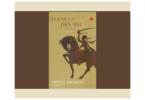“Every action has an equal and opposite reaction.” said Newton’s Third Law, and that seems to be the theme of Sharath Kommarraju’s latest novel The Rise of Hastinapur. This book is not a sequel to his first novel The Winds of Hastinapur. It is not even a retelling of the famous epic. It is instead a set of 3 stories which are part fiction and part true; 3 stories that were underplayed in the original epic and yet shaped the epic itself.
The Rise of Hastinapur is the story of Amba – the Princess of Kasi, in love with Salva, the Kind of Saubala. At her swayamvara (groom-choosing ceremony), she, along with her sisters Ambika and Ambalika are abducted by Bhishma, to be wedded to his half-brother Vichitraveerya. What unfolds is a tale of love, betrayal, hatred and vengeance that gives birth to the first crack in the foundation of the Great Kingdon of Hastinapur that Bhishma is painstakingly building.
The Rise of Hastinapur is the story of Kunti – born as Pritha, the Princess of Kunti, sister to Vasudeva and Krishna’s aunt. Kunti had nothing against Bhishma or Hastinapur, except a sense of entitlement, placed in her mind by the (spoiler-alert*) Celestial Surya. She grows up with the knowledge that she will bear the kings who will rule the Kingdom of Hastinapur and unite all of North Country, while she will be the Queen Mother. Knowing the future is a dangerous thing, and expectations can lead to great calamities; Komarraju does an excellent job of explaining why through the story of Kunti.
The Rise of Hastinapur is the story of Gandhari – Queen of the prosperous kingdom of Gandhara and sister of Shakuni, the man who plots the downfall of Pandavas in the original epic. However unlike the original where Gandhari is the least spoken of female character of note, Komarraju’s Gandhari is wise, ruling over the Kingdom of Gandhar justly. However when her kingdom is taken away from her by deceit by Bhishma, she plots revenge, marrying into the royal family of Hastinapur as the first step towards fulfilling that revenge, thus creating another crack in Hastinapur’s foundations. Gandhari’s story is probably the only one that deviates from the one in the epic to a large extent.
- Also read The Rise of Kali – Duryodhana’s Mahabharata – Book Review
Through the entire book, one wonders about the true intentions of Bhishma. Known popularly as the force that brought about the golden period in Hastinapur and united the whole of Bharata varsha into one, the book makes you introspect about the true motives of the Son of Ganga. Was he an instrument of the Gods sent to ensure that the race of men meets its pre-destined end, for what rises to great heights also falls harder? One tends to think yes, for he carefully sows the seeds of revenge in the hearts of those who can carefully plot it. The fact is corroborated by the final chapter of Komarraju’s book, a conversation between the Lady of the River and Kubera, in which she indicates the impending end of the Dwapara Yuga.
While The Rise of Hastinapur does not carry the linguistic brilliance of the author’s first novel, and in some places the narration becomes tedious, it is certainly deeper in meaning and gives a lot of food for thought. We recommend reading it.
If you have already read it, let us know your views of the book in the comments below.
GoodReads rating: 4.3/5.0
Be a good Samaritan: If you liked this review, please share it with others. If you did not, share it with us in the comments below 
We regularly publish original book reviews. Contact us if you are an author/publisher and want us to review your work.
Our affiliates:
If you would like to purchase ‘The Rise of Hastinapur’ by Sharath Komarraju, you can do so from our affiliates at
Flipkart: The Other End of the Corridor
Amazon (Paperback): The Rise of Hastinapur
Amazon (Paperback): The Rise of Hastinapur
Tell-A-Tale gets a small share of the purchases you make from the affiliate link, helping us bring you the stories you love to read





I loved The Murder in Amaravati by Sharath. I feel he should write more mysteries like that. Will check out his latest book soon…
Destination Infinity